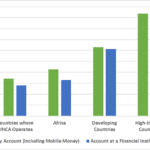Opportunity or Threat: Are Healthy Partnerships Possible Between Digital Financial Services and Microfinance Institutions in Bangladesh?
Bangladesh is home to a large number of globally recognized microfinance institutions (MFIs), along with many smaller MFIs that operate various community-based microcredit programs throughout the country. According to the government’s Microcredit Regulatory Authority report from 2019, the microfinance sector in Bangladesh is comprised of 724 licensed NGO-MFIs, serving 32.37 million clients with a total outstanding loan portfolio of almost BDT 787 billion (US $9 billion).
Digital financial service (DFS) providers have been trying to partner with the country’s MFIs, offering them the value propositions of cashless loan disbursement and repayment via installment payments, and savings deposits through digital wallets. There are four key rationales driving DFS providers’ interest in these partnerships:
- Microfinance has the largest financial service branch network in Bangladesh, with 18,977 branches across the country. DFS providers can leverage this network infrastructure to facilitate a quick and efficient expansion in their outreach.
- A majority of microfinance beneficiaries are women, and their adoption of DFS will reduce the gender divide in digital inclusion.
- The digital transformation of MFIs will enable them to offer value–added services to their customers.
- Synergy between DFS and microfinance, two key financial service sectors, will transform the overall market and enable more value propositions for DFS providers, MFIs, regulators and customers.
Partnership Between Digital Finance and Microfinance: A History of Challenges
Despite these benefits, it took almost a decade for the two sectors to realize the benefits of partnerships. And over the years, different attempts at partnership have met with varying degrees of success. For instance, partnerships between mobile financial services (MFS) providers like bKash and Rocket and MFIs like BURO and Shakti Foundation did not progress much on loan disbursement through MFS wallets, due to challenges involving transaction limits and the cost of cash withdrawal. However, thanks to its huge efforts to boost customers’ digital financial literacy, BRAC’s attempt to use bKash’s digital wallet to facilitate savings deposits seems to have had some meaningful impacts. In contrast, an agent banking partnership between Bank Asia (where I serve as a Senior Vice President), BURO and Shakti Foundation didn’t go well, due to the conflict of interest inherent to serving the same target clients with similar products and services.
These partnerships face a number of other common challenges. For instance, according to internal industry research, key MFIs in Bangladesh have a minimum average loan size in the range of BDT 30,000 – 50,000 (~US $350 – 590), and their enterprise loan schemes can go up to BDT 200,000 – 500,000 (~US $2,360 – 5,900). Quick access to the full loan amount is one attractive feature of MFI loans, but a lack of liquidity among MFS agents means that customers are often not able to withdraw the entire loan in one transaction. That means a loan recipient using MFS channels would have to visit the agent outlet several times to withdraw the full loan, due to the maximum cash-out transaction limit of BDT 25000 (~US $290) per day set by the central bank. And the customer would need to pay the required cash-out charge each time, increasing their effective interest rate.
Nevertheless, customer acceptance of mobile finance suggests that there’s ample scope for mutually beneficial partnerships between MFIs and MFS providers. For instance, an earlier study (unavailable online) on transaction limits in MFS revealed that 87% of female MFI customers say the simplicity of MFS use makes it convenient for them. And 93% mentioned that the speed of these transactions makes MFS ideal for sending/receiving money at any time of the day, without the need to travel anywhere.
In order to pave the way for greater partnership, MFS providers and MFIs should focus on some quick wins. MFS providers can start by strengthening the value proposition of mobile services for both MFIs and their customers, as these customers are not currently able to leverage MFS platforms to the full extent. This could be accomplished by setting different transaction limits and charges for MFI customers, provided the MFS providers have the technology in place to differentiate between the mobile wallets of MFI users and those of their general customers. This sort of initiative could be piloted under a regulatory sandbox mechanism, as I discussed in a previous NextBillion article.
Addressing a Fundamental Challenge
However, those approaches wouldn’t address the more fundamental challenge mentioned above: the conflict of interest that comes from serving the same target clients with overlapping products and services. Like their MFI counterparts, some DFS providers in Bangladesh now also offer microloans to low and moderate-income households in rural and urban geographies, putting the two sectors into direct competition.
Even in light of this, partnership models do exist. For instance, a few MFIs and agent banking providers have joined hands to serve these customers. Agent banking refers to banking services provided outside of regular bank branches by engaged agents of the bank, using biometric point-of-service devices installed at agent outlets, which are exclusive for the bank and distinctly branded by various permanent marketing and point-of-sale materials. It aims to facilitate banking services to underserved segments of the population, especially those from geographically dispersed locations who don’t have access to mobile phones. Regulators view agent banking as distinct from MFS, though MFS providers also employ agent networks to deliver their services. An agent banking outlet requires 10-15 times higher investment than is needed for a typical MFS agent outlet.
Agent banking providers have partnered with MFIs using the following approaches:
- MFIs become master agents of the agent banking provider — meaning the MFI’s branches are contracted by the bank to offer its agent banking services. However, this model still clearly has a conflict of interest: Both the MFI and the agent banking provider are offering loan and savings products to customers through agent banking.
- MFIs use agent banking outlets for payment digitization — enabling digital loan disbursement, loan repayment and savings deposits. For MFIs, handling payment digitization through agent banking is better than conducting it through MFS agent networks, as there are no transaction limitations and high cash-out charges, as in the case with MFS. However, there is a conflict of interest in this model too, as a customer can also open and deposit savings in a bank account at an agent banking outlet, just as they can with an MFI using that outlet.
Neither of these models is perfect. Both have ambiguity in how MFIs and agent banking providers define their respective roles (as master agent and agent outlet) and responsibilities (for engaging full-time staff, handling cash management and its associated risks, etc.), and how they handle profit-sharing and avoid future competition and product cannibalization. Importantly, microfinance regulators and MFI-affiliated bodies like the Credit and Development Forum also seem skeptical that there’s a clear business model of collaboration between MFIs and agent banking.
Working Toward Greater Collaboration Between Microfinance and Digital Finance
Though at present we only see poor partnership paradigms in the country, MFIs and fintechs can better serve grassroots customers if they work together. MFIs offer unmatchable convenience that can help fintechs reach new customers, as they provide credit disbursement and repayment at the customer’s doorstep, while requiring minimal documentation for Know Your Customer and creditworthiness assessment purposes. MFIs also have embedded various social programs into their services, such as skill development training, preventive healthcare, value chain development, etc. This means there is the additional benefit of social capital and skill-building if a fintech associates with an MFI.
Greater collaboration with fintechs is also beneficial for MFIs — in fact, it is increasingly a necessity, as they react to a global digital finance revolution driven by external factors they can’t control. MFIs in Bangladesh and around the world have realized that competition is coming from multiple directions, from banks, fintechs and other specialized financing institutions, which means their market share will shrink. They will need to develop careful strategies for the future, enabling them to leverage the innovations that fintechs can offer in digital savings and credit, along with other ancillary services like bill payment, money transfer, etc. — without losing their customers or their niche within the broader financial services sector.
The potential for these partnerships is becoming stronger, as microfinance’s traditional customers in Bangladesh are increasingly receptive to digital finance. One need look no further than the pandemic-driven boost in agent banking, or BRAC’s success in disbursing digital cash transfers to help families during the lock-down, to see this shift. And it is quite evident that even those customers who are still averse to using digital devices or tools can be brought into the digital ecosystem, if we can ensure appropriate inclusion and impact through meaningful innovation. The looming synergy between the country’s two financial regulators, Bangladesh Bank and the Microcredit Regulatory Authority, should also help to embed digital innovation more firmly within the microfinance sector. As key actors in the industry move toward this inevitable market transformation, Bangladesh is certain to see new digital initiatives that prioritize customers’ needs, while focusing on convenience, cost and context.
Jakirul Islam is a Senior Vice President of Bank Asia.
Photo courtesy of WorldFish.
- Categories
- Finance, Technology



